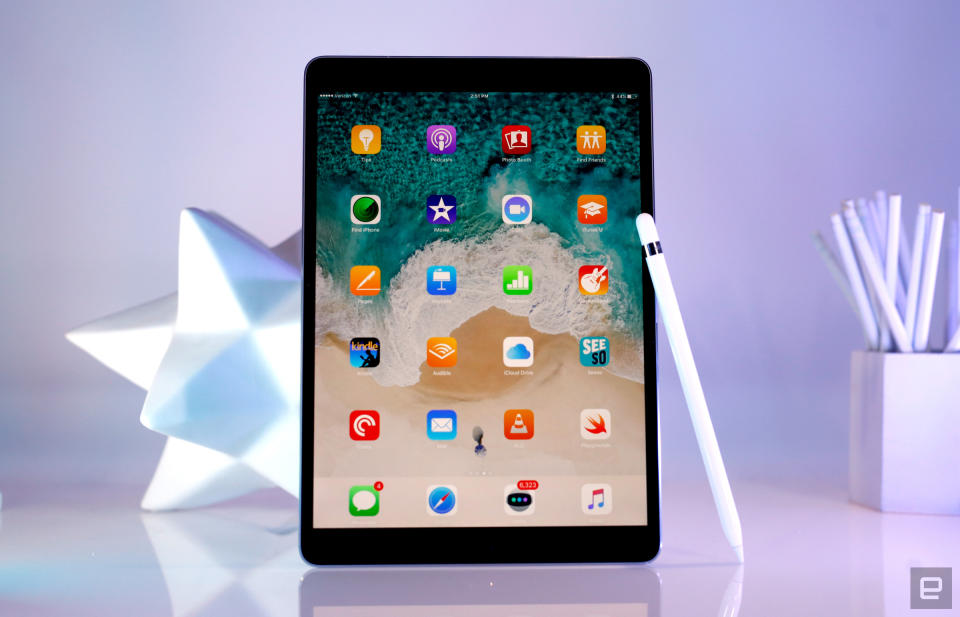iPad Pro 10.5 review: Where execution and ambition meet
It’s an excellent tablet with the potential to get even better.
Never mind that Apple keeps updating its notebooks and desktops -- Tim Cook once said the iPad represented the future of personal computing. That was one year ago, when the company revealed the 9.7-inch iPad Pro, and he seemed to mean it. Of course, you don't need me to tell you that a lot can happen in a year.
The iPad that Phil Schiller revealed after Cook dropped that bombastic statement has already been discontinued, making way for the shiny new 10.5-inch model Apple unveiled at WWDC 2017. The Pro 10.5 ($649+) feels very familiar, not to mention surprisingly powerful, but that's no surprise -- every new iPad Pro that Apple releases is the best one out there. What's more impressive is how finally -- finally -- Apple has put together an iPad that feels capable of living up to the company's lofty words. It's not perfect, and it's not for everyone, but the iPad Pro 10.5 is still a bigger step forward than I expected.
Hardware
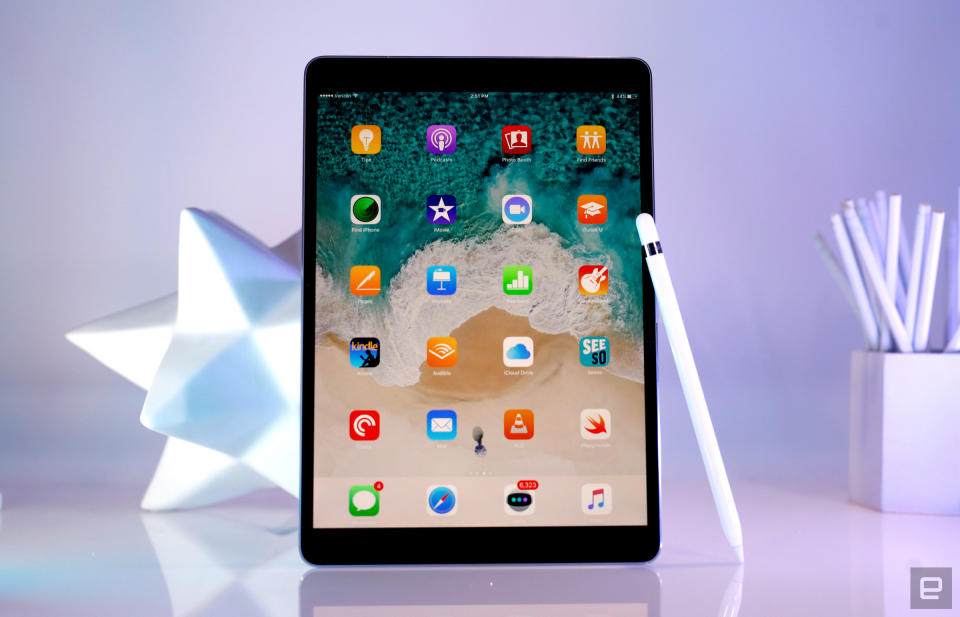
If you've ever so much as looked at an iPad Pro, you know what to expect. The Pro 10.5's body is crafted from a single block of aluminum, and it's as sturdy and seamless as the previous model. There's a sleep/wake key on the top-right corner, and a few millimeters around the corner from that are the volume keys. Going down from there, you'll find the nanoSIM card slot -- that is, if you've splurged on a cellular model.
The usual quartet of speakers is back, too, etched in pairs into the iPad's top and bottom edges. And on the left side: the three-pin Smart Connector that provides power and data connectivity for a slew of fancy Pro-series accessories.
Really, there's only one clear sign that you're looking at a different kind of iPad. Look at the screen — or more accurately, look around the screen. The Pro 10.5 has much smaller bezels because Apple squeezed a larger panel into a body that's only slightly bigger than the 9.7-inch model.
The other changes are apparent only when you turn the iPad on. The improved Touch ID sensor in the home button is noticeably faster than the one in the last Pro, for one, and Apple raised the storage minimum across all Pro models. The base is now 64GB, though the model I'm testing has a whopping 512GB. That's as much storage as the laptop I just bought, a sign that Apple wants the iPad Pro to be able to stand in for a traditional computer when needed.
Display and sound
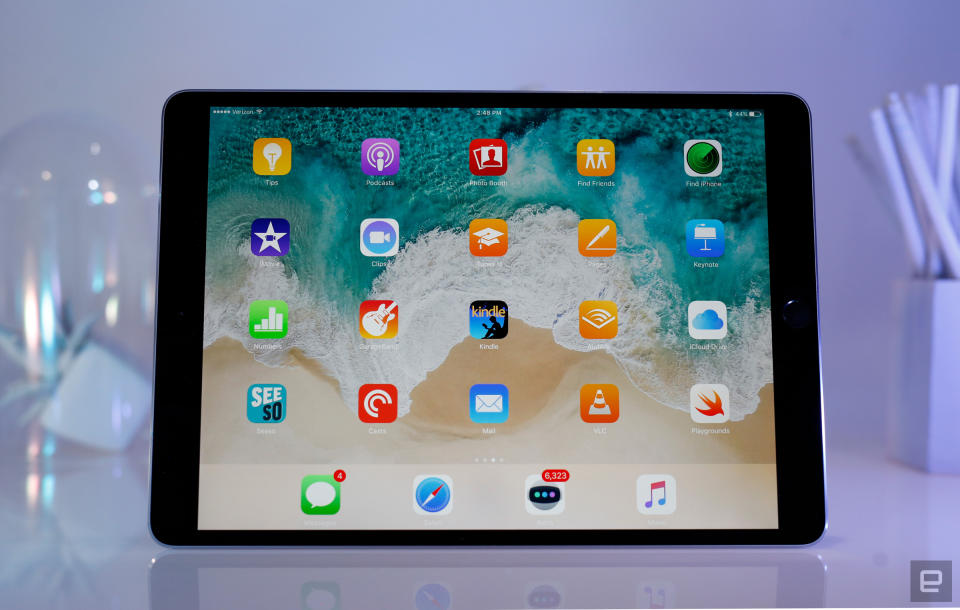
Both of the earlier iPad Pro models had good screens, but neither were all that exciting. Not so this time: The Pro 10.5's display is fantastic. For one, it's a little bigger than the panels Apple once used in its iPads. I really like the 12.9-inch Pro in theory, but it was always too hefty to lug around (especially since I often have a laptop with me, anyway). And the 9.7-inch Pro was fine for reading and video, but less than ideal when I needed to get work done. It honestly would've been nice to get an even bigger screen this time — say, 11 inches — but Apple's size decision here was at least a step in the right direction. And because Apple bumped this screen's resolution to 2,224 x 1,668, it's just as crisp as every other Retina iPad display.
This is also Apple's first ProMotion screen, which means it refreshes at a rate of 120Hz instead of the typical 60Hz. As a result, scrolling and animations are almost startlingly smooth. Your TV probably has a similar feature, which makes actors on-screen look like they're walking around a soundstage instead of their fictional world. Here, it just makes the action look more fluid, as though the icons you're pushing around a home screen are real objects. Frankly, I don't want to go back to a non-ProMotion iPad after this.
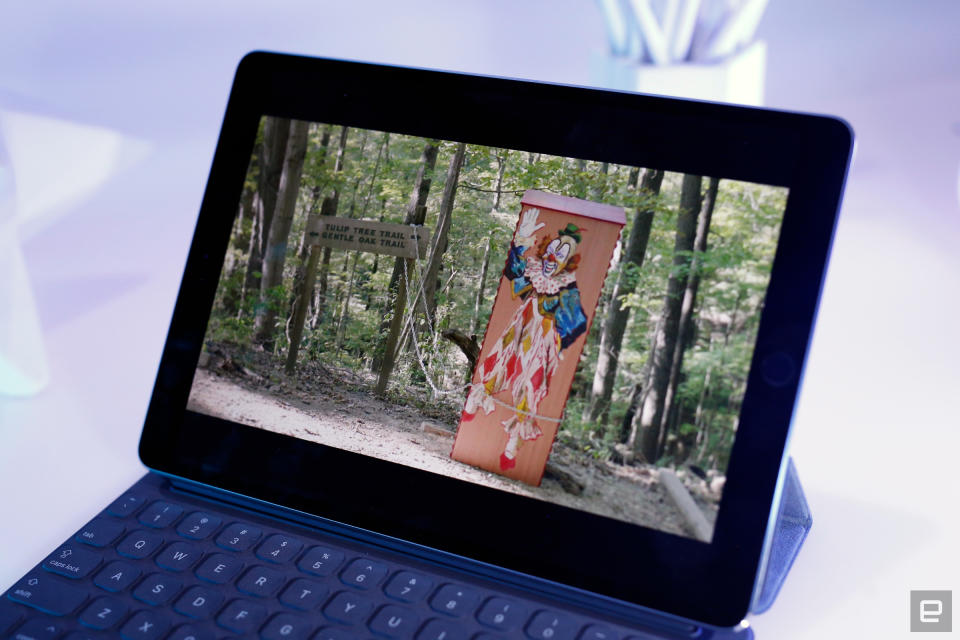
While similarities to televisions are fresh in our minds, the Pro 10.5 also packs support for the DCI-P3 wide color gamut. This first debuted on last year's iPad Pro, and it just means colors here are livelier and more saturated. Beyond that, this is also one of the brightest iPad screens I've ever seen. It tops out at around 600 nits, putting it ahead of many existing tablets, not to mention quite a few laptops. That brightness makes this model a champ for watching movies in well-lit environments, and an improved anti-reflective coating also means it's great for outdoor use, too. Throw in True Tone, which changes the screen's color temperature based on your surroundings, and you've got one of the most technically impressive displays Apple has ever made.
As mentioned, the 10.5 has the same four-speaker setup we've seen in earlier Pro models. They're not quite enough to fill a room, but they offer loud, crisp audio without distortion. I spent a lot of time watching cooking videos on YouTube while futzing around in my kitchen, and the Pro 10.5 was always audible above the domestic din. I have Apple's speaker design to thank for a lot of that clarity -- all four speakers play low-frequency sound, but only the top two play the mids and highs. That clever trick makes for surprisingly good channel separation for movies and music, though the benefits are less clear for audiobooks and podcasts.
Performance and software
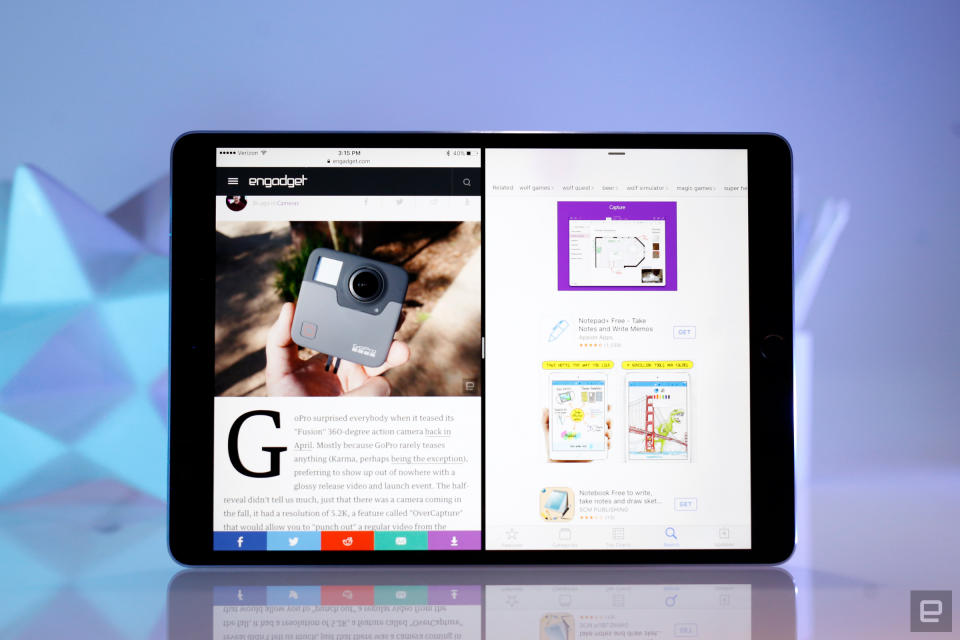
Not to sound too enthusiastic, but the superlatives don't end with the screen. Thanks to Apple's A10X Fusion chip (a more powerful spin on the processors used in the iPhone 7), an updated GPU and 4GB of RAM, this is the most powerful iPad to date. Apple says CPU speeds here are 30 percent faster than last year's Pro, and that graphics speed has improved 40 percent. Our usual set of benchmarks (below) certainly point to some big performance gains, but here's the most important thing: Hardly anything I threw at the Pro over a week of testing managed to trip it up.
Working for Engadget involves a lot of multitasking, so I often had two apps — like Slack and Safari — running side by side in iOS's Split View mode. Things sometimes felt a little cramped, but everything ran smoothly. Visually intense games like Monument Valley 2, Skullgirls and Telltale's Guardians of the Galaxy were no problem for the Pro either and actually seemed to get a visual boost thanks to the ProMotion screen. Even editing multiple 4K video files in iMovie was a surprisingly painless process, partially because the updated 12-megapixel camera can shoot native 4K footage. (You'll still look a little ridiculous taking photos and video with a tablet, but at least the results will be worth it.)
iPad Pro 10.5 | iPad Pro 12.9 (Gen.1) | iPad Pro 9.7 | |
|---|---|---|---|
Geekbench 4 Multi-core | 9,185 | 5,379 | 5,235 |
Geekbench 4 Single-core | 3,885 | 3,012 | 2,930 |
3DMark IS Unlimited | 54,163 | 32,544 | 33,403 |
GFXBench 3.0 Manhattan Off/onscreen (fps) | 109.5/58.3 | 79.3/33.6 | 51.2/34.9 |
Mozilla Kraken (ms) | 1,003 | 1,499 | 1,512 |
JetStream 1.1 | 203 | 141 | 139 |
Kraken: Lower scores are better. | |||
But what about professional apps? You know, the high-end stuff artists, designers and doctors use? I threw a couple extra layers on top of a RAW image in Affinity Photo and tweaked the whole thing in real-time. I noticed the occasional hiccups when I tried to quickly leap into another app, but it wasn't anything concerning. (Because I tested the Pro before its official launch, it's also possible the version of the app I tried out wasn't optimized for it yet.) Meanwhile, I suck at 3D modeling, but apps like UMake and Formit 360 gave me the tools to at least try cobbling 3D structures together; any failures of performance here belong to me, not the hardware.
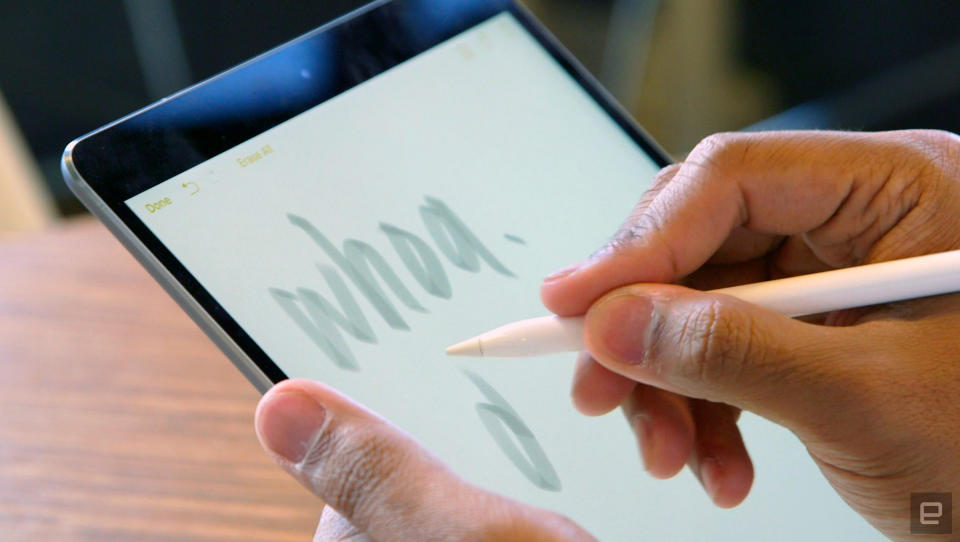
Long story short, the Pro 10.5 acts the way you'd want an expensive tablet to. Nearly everything feels effortlessly fast — now we just need the software to catch up to the hardware. This Pro ships with iOS 10.3, which isn't technically bad, it's just that iOS 10 didn't add many truly valuable iPad-specific features. That's about to change. Apple calls iOS 11 a "monumental leap" for the iPad, with additions like a customizable dock for quick access to apps and the ability to drag and drop content between two apps running side-by-side. These may sound like minor changes, but they seem essential for anyone actually trying to get work done on an iPad Pro.
Remember Tim Cook's words: The iPads are meant to be the company's "clearest expression" of the future of personal computing. It was a nice sentiment and the hardware that accompanied it was very good, but iOS leaves much to be desired on bigger screens. With the eventual launch of iOS 11, though, iPads will finally get some much-needed flexibility -- in other words, the iPad's best days are yet to come.
Battery life
Battery life (in hours) | |
|---|---|
iPad Pro 10.5 | 9:40 |
Samsung Galaxy Tab S3 | 11:50 |
Lenovo Yoga Book (Android) | 11:09 |
iPad Pro 12.9 | 10:47 |
iPad Pro 9.7 | 9:21 |
Google Pixel C | 8:15 |
Surface Pro 4 | 7:15 |
This version of the iPad Pro packs a 30.4Whr battery and, as usual, Apple claims you'll be able to use it for up to 10 hours while watching movies or putzing around online. In general, Apple's estimates were always on the conservative side; we've had our share of iDevices easily surpass the 10-hour mark in our battery-rundown test. This time, though, Apple's figure was more or less right-on. On three occasions, I set the Pro 10.5 to loop a movie with Wi-Fi on and screen brightness set to half, and on average the tablet lasted for about nine hours and 40 minutes before needing a trip to a power outlet.
That's actually a little better than last year's model, but not by much. The Pro 10.5 has a bigger battery than the Pro 9.7, but it also has to deal with a brighter screen that refreshes twice as fast. (The A10X Fusion chip obvious plays a role here too, but it was designed to more efficiently sip power when needed.) Anyway, most of you aren't sitting around running video benchmarks all day. With fairly consistent use (by which I mean I barely put it down) and screen brightness set to auto, the iPad Pro lasted about three days before needing a charge. If you're the type who picks up an iPad, checks a few things out and tosses it back down again, expect it to last even longer.
Accessories
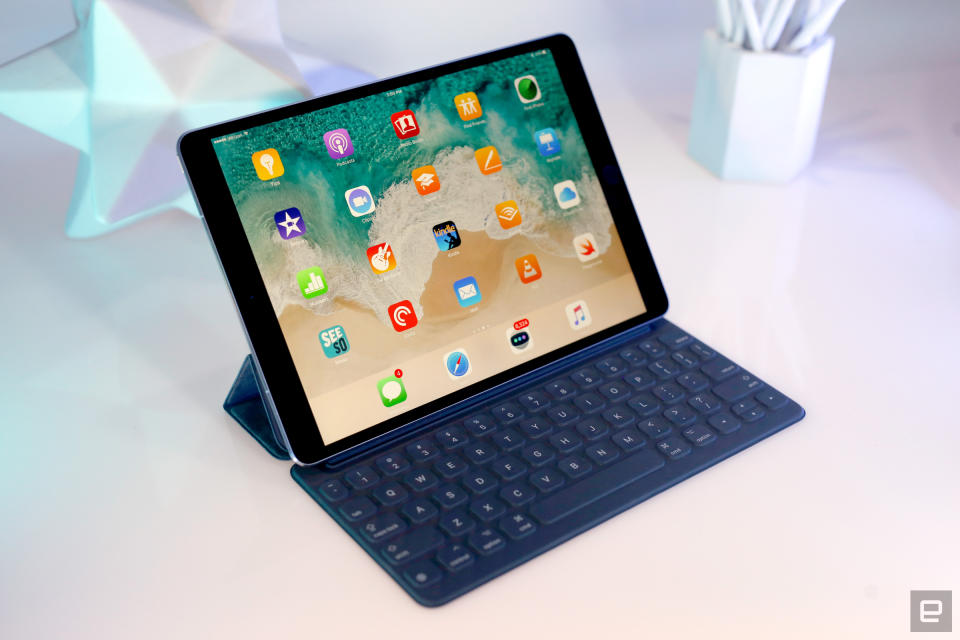
Two accessories have been synonymous with the iPad Pro since the beginning: the $99 Apple Pencil and the $159 Smart Keyboard case. The former actually hasn't changed since we first saw it two years ago. Thanks to the Pro 10.5's improved screen, however, writing and sketching feel far more fluid than on older models. Let's say you're tracing a curvy line — there's only about a 20-millisecond delay between moving the Pencil and seeing the line appear on-screen. I don't know about you, but my eyes aren't discerning enough to pick up on latency that subtle.
The keyboard situation is much improved, too. Because there's never been a Pro this size before, Apple had to make a smart keyboard case that is slightly larger than the one it made for the 9.7-inch Pro last year. Despite that modest change in size, this year's model is much, much more comfortable. For one, the keys are nicely spaced and bigger — I actually typed most of this review on the Pro with a smart keyboard, something I just couldn't manage last year. In fact, it's so much better that people with the smaller iPad Pro should seriously consider buying this keyboard instead. It's not so big as to feel clunky when closed over the screen, and the improved keys are worth it.
The competition
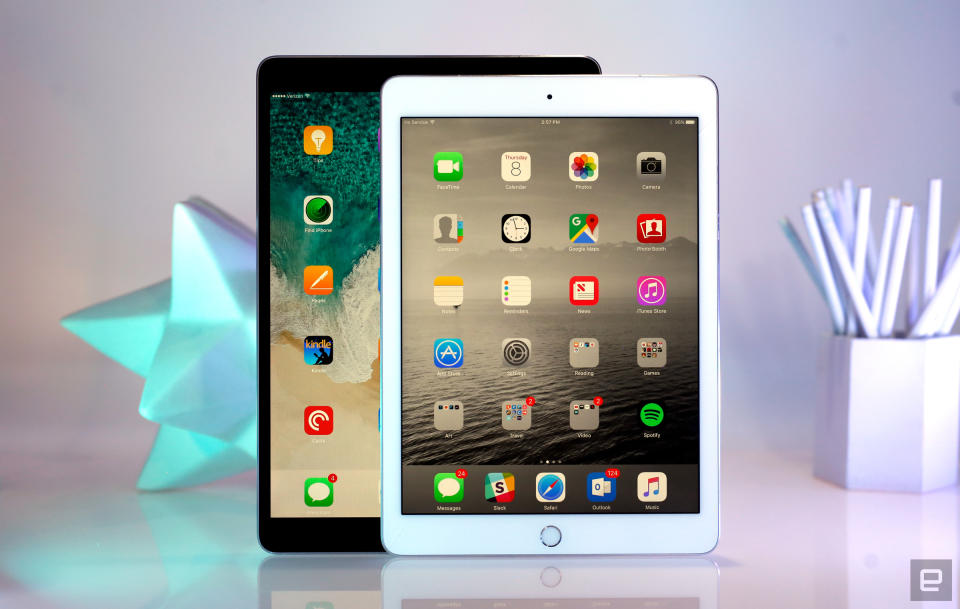
Real talk: There just aren't many premium tablets on the market. This iPad is obviously one of them. For not much extra, you could also move into the 12.9-inch iPad Pro, which quietly got the same upgrades. The brighter, ProMotion screen? The A10X Fusion chip? That camera from the iPhone 7? Yes, oui and ja. Aside from the shift in the size, the only real differences are the battery sizes and color options. Only the Pro 10.5 comes in rose gold, which I'm sure matters to some of you. That said, the bigger screen makes running multiple apps much less painful. That'll be even more important once iOS 11 hits.
Meanwhile, if you're on the lookout for a high-end tablet but just hate Apple, there's always the Galaxy Tab S3. You're not wrong to look at it as Samsung's answer to the iPad Pro — it packs a relatively high-end (if somewhat older) mobile chipset, a great screen with HDR support and an S Pen for all you creative types. Even better, there's an optional keyboard case for when the urge to get productive strikes. Here's the rub: If you thought iOS wasn't tuned for productivity, Android seems even worse. With prices starting at $600, it's a fine alternative; I just wish there were more (and better) Android tablet apps.
Wrap-up
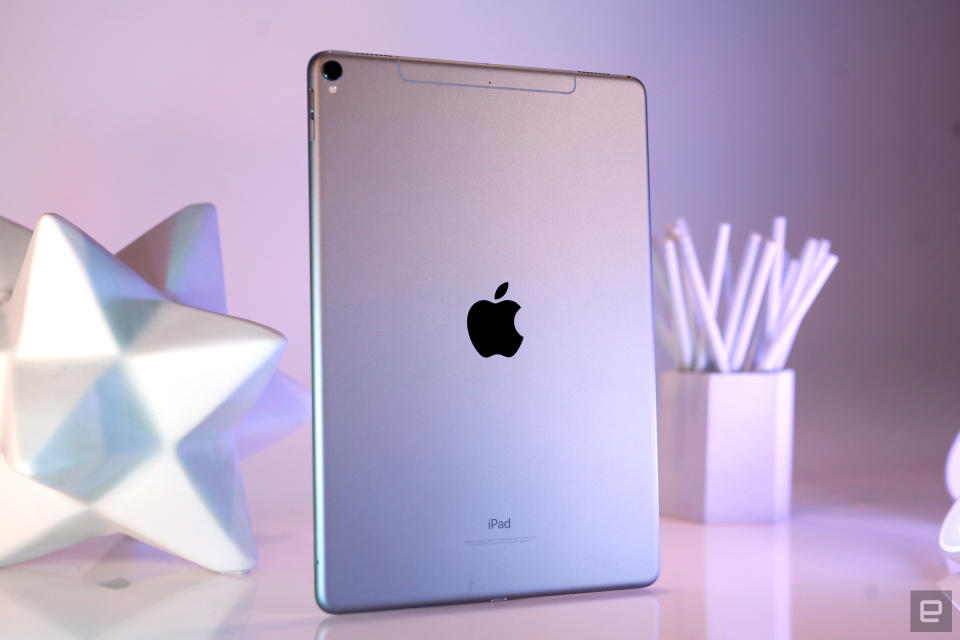
No matter how you slice it, $649 is a lot of money to drop on an iPad. In return, however, you get one of the most powerful tablets around. Most people like the idea of a second screen for occasional web browsing on the couch when they can't be bothered to move to a computer or dig a phone out of their pocket. If that's you, just forget it: The iPad Pro 10.5 is total overkill.
That said, it's not hard to find scenarios where this pricey Pro actually makes sense. If you're a photographer looking for a better way to edit RAW files in the field, this might be for you. Ditto for videographers and producers looking to piece together rough cuts without running for a workstation. And if you're the kind of person contemplating a life without a traditional PC at home or in your bag, the power on display make the Pro 10.5 a good place to start ... though you may want to wait until iOS 11 launches. Long story short, this is an excellent machine with tons of untapped potential. Just make sure that it actually fits your lifestyle before dropping the cash on one.

